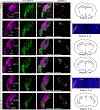Projections of ipRGCs and conventional RGCs to retinorecipient brain nuclei
- PMID: 33104235
- PMCID: PMC10081000
- DOI: 10.1002/cne.25061
Projections of ipRGCs and conventional RGCs to retinorecipient brain nuclei
Abstract
Retinal ganglion cells (RGCs), the output neurons of the retina, allow us to perceive our visual environment. RGCs respond to rod/cone input through the retinal circuitry, however, a small population of RGCs are in addition intrinsically photosensitive (ipRGCs) and project to unique targets in the brain to modulate a broad range of subconscious visual behaviors such as pupil constriction and circadian photoentrainment. Despite the discovery of ipRGCs nearly two decades ago, there is still little information about how or if conventional RGCs (non-ipRGCs) target ipRGC-recipient nuclei to influence subconscious visual behavior. Using a dual recombinase fluorescent reporter strategy, we showed that conventional RGCs innervate many subconscious ipRGC-recipient nuclei, apart from the suprachiasmatic nucleus. We revealed previously unrecognized stratification patterns of retinal innervation from ipRGCs and conventional RGCs in the ventral portion of the lateral geniculate nucleus. Further, we found that the percent innervation of ipRGCs and conventional RGCs across ipsi- and contralateral nuclei differ. Our data provide a blueprint to understand how conventional RGCs and ipRGCs innervate different brain regions to influence subconscious visual behaviors.
Keywords: Circadian rhythms; Melanopsin; Parallel pathways; Pupillary light response; Retinofugal projections; Retinohypothalamic tract; ipRGCs; nonimage forming visual functions.
© 2020 Wiley Periodicals LLC.
Figures











References
-
- Baver SB, Pickard GE, Sollars PJ, and Pickard GE (2008). Two types of melanopsin retinal ganglion cell differentially innervate the hypothalamic suprachiasmatic nucleus and the olivary pretectal nucleus. Eur. J. Neurosci 27, 1763–1770. - PubMed
-
- Cunningham JT, Penny ML, and Murphy D. (2004). Cardiovascular regulation of supraoptic neurons in the rat: Synaptic inputs and cellular signals. Prog. Biophys. Mol. Biol 84, 183–196. - PubMed
Publication types
MeSH terms
Grants and funding
LinkOut - more resources
Full Text Sources
Research Materials

